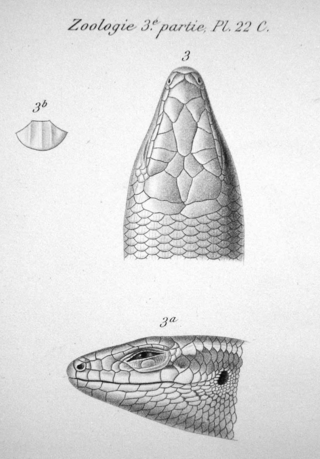
Marlins are fish from the family Istiophoridae, which includes 11 species.

Lygodactylus is a genus of diurnal geckos with 82 species. They are commonly referred to as dwarf geckos. They are mainly found in Africa and Madagascar although two species are found in South America. Lygodactylus picturatus, the best known species, is found in Kenya and commonly known as the white-headed dwarf gecko. Recently, illegal importation from Tanzania of brightly colored, Lygodactylus williamsi, known as electric blue geckos, has been gaining attention for Lygodactylus geckos in the reptile trade.

Paragehyra is a genus of lizards in the family Gekkonidae (geckos). The genus is endemic to Madagascar.
Paracontias is a genus of skinks, lizards in the family Scincidae. The genus is endemic to Madagascar.

Enric Miralles Moya was a Spanish architect from Barcelona, Catalonia. He graduated from the Barcelona School of Architecture (ETSAB) at the Universitat Politècnica de Catalunya (UPC) in 1978. After establishing his reputation with a number of collaborations with his first wife Carme Pinós; the couple separated in 1991. Miralles later married fellow architect Benedetta Tagliabue, and the two practiced together as EMBT Architects. Miralles' magnum opus and his largest project, the Scottish Parliament Building, was unfinished at the time of his death.

Fitzroya is a monotypic genus in the cypress family. The single living species, Fitzroya cupressoides, is a tall, long-lived conifer native to the Andes mountains and coastal regions of southern Chile, and only to the Argentine Andes, where it is an important member of the Valdivian temperate forests. Common names include alerce, lahuén, and Patagonian cypress. The genus was named in honour of Robert FitzRoy.

Sciurini is a tribe that includes about forty species of squirrels, mostly from the Americas. It includes five living genera—the American dwarf squirrels, Microsciurus; the Bornean Rheithrosciurus; the widespread American and Eurasian tree squirrels of the genus Sciurus, which includes some of the best known squirrel species; the Central American Syntheosciurus; and the American pine squirrels, Tamiasciurus. Like other arboreal squirrels, they are sometimes referred to as tree squirrels.

Cambarellus is a genus of small freshwater crayfish in the family Cambaridae. The 19 species are found in Mexico and the Gulf States of the United States. Among the Mexican species, C. areolatus, C. patzcuarensis, and C. prolixus are considered seriously threatened by the IUCN, and C. alvarezi is already extinct. C. chihuahuae was also believed to be extinct until rediscovered in 2012. C. alvarezi and four undescribed, extinct Cambarellus species were restricted to desert spring systems in southwestern Nuevo León; each one shared its habitat with a Cyprinodon pupfish.

Procambarus is a genus of crayfish in the family Cambaridae, all native to North and Central America. It includes a number of troglobitic species, and the marbled crayfish (marmorkrebs), which is parthenogenetic. Originally described as a subgenus for four species, it now contains around 161 species.

Typhlatya is a genus of shrimp in the family Atyidae. These are small, stygobitic shrimp found in the West Mediterranean region, Caribbean region, Ascension Island and the Galápagos, although the individual species often have very small ranges. Species in this genus are found in salt, brackish and fresh waters, mostly in anchialine habitats and none in the open sea.

Gephyromantis is a frog genus in the mantellid subfamily Mantellinae. This genus is restricted to Madagascar. At present it contains 45 species divided into six subgenera.

The Noronha skink is a species of skink from the island of Fernando de Noronha off northeastern Brazil. It is covered with dark and light spots on the upperparts and is usually about 7 to 10 cm in length. The tail is long and muscular, but breaks off easily. Very common throughout Fernando de Noronha, it is an opportunistic feeder, eating both insects and plant material, including nectar from the Erythrina velutina tree, as well as other material ranging from cookie crumbs to eggs of its own species. Introduced predators such as feral cats prey on it and several parasitic worms infect it.

Trachylepis maculata, the spotted mabuya, is a species of skink in the genus Trachylepis recorded from Demerara in Guyana, northern South America. It is placed in the genus Trachylepis, which is otherwise mostly restricted to Africa, and its type locality may be in error. It is an unstriped, olive-brown, grayish animal, with dark spots all over the body. Its taxonomic history is complex due to confusion with Trachylepis atlantica from the Atlantic Ocean island of Fernando de Noronha and doubts regarding its type locality.
Under the International Code of Zoological Nomenclature (Code), the name-bearing type or onomatophore is the biological type that determines the application of a name. Each animal taxon regulated by the Code at least potentially has a name-bearing type. The name-bearing type can be either a type genus, type species, or one or more type specimens. For example, the name Mabuya maculata has often been used for the Noronha skink, but because the name-bearing type of the former, a lizard preserved in the Muséum national d'histoire naturelle in Paris, does not represent the same species as the Noronha skink, the name maculata cannot be used for the latter.
Trachylepis tschudii is an enigmatic skink, purportedly from Peru. First described in 1845 on the basis of a single specimen, it may be the same as the Noronha skink (T. atlantica) from Fernando de Noronha, off northeastern Brazil. T. tschudii represents one of two doubtful records of the otherwise African genus Trachylepis on mainland South America; the other is T. maculata from Guyana.

Madascincus is a genus of skinks, lizards in the family Scincidae. The genus is endemic to Madagascar. Some taxonomic authorities place the group in the genus Amphiglossus.

Chordodidae is a family of parasitic horsehair worms belonging to the order Gordioidea; its taxonomy is under review.

Acutogordius is a genus of worms belonging to the family Gordiidae.
Beatogordius is a genus of worms belonging to the family Chordodidae.
Pseudochordodes is a genus of worms belonging to the family Chordodidae.














